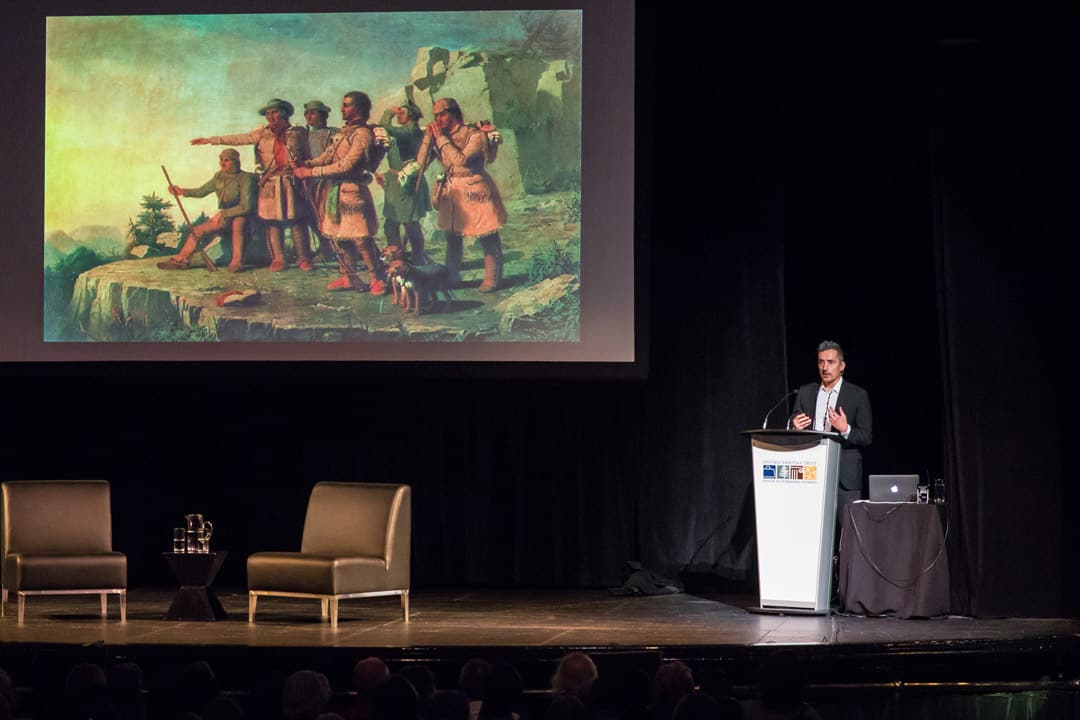At first glance, the Winter Garden Theatre is gorgeous. There are hundreds of tiny lights dotted around the ceiling, interspersed with a thick foliage of colourful leaves and twisting vines that make up the underside of the only operating two-tiered Edwardian theatre in the world.
On the night of November 14, the theatre was packed with people eager to see Kent Monkman, renowned Cree painter and artist, and the mastermind behind the Shame and Prejudice: A Story of Resilience exhibition.
First showcased in the University of Toronto Art Museum for Canada 150, Shame and Prejudice was just a portion of Monkman’s prolific output, charting the trajectory of Canadian art history itself.
And that is what we had all gathered for: Monkman’s lecture, titled “Decolonizing Art History.”
Throughout the lecture, Monkman displayed an array of images from photographs to paintings, and sculpture to film stills and etchings. He began with several introductory images of the works of early settler-colonial painters, whose vast, lush paintings depict rich green forests and towering mountains that stretch into the distance.
Often the sun is shown bursting up from behind these mountains, denoting “biblical subjects transposed to North America,” as Monkman explained. The greenery and golden glow of the sun was not entirely at odds with the beautiful interior of the theatre — yet it was there that Monkman shattered the beauty of these early settler-colonial paintings.
The vast, gorgeous landscapes were barren of people, except for the European settlers who ‘discovered’ the land.
Many of Monkman’s earlier works were direct responses to these pieces, and inspired his transition from abstract to representational.
The first painting Monkman discussed was William Ranney’s “Boone’s First View of Kentucky,” which shows a sweeping skyline, with a small band of European settlers in the foreground, surveying the land before them. This use of nature as a vast empty space to conquer effectively painted over the very real Indigenous people who lived in these places before white settlers arrived.
Monkman admitted that he “rejected everything that [he] learned in college because [he] thought that representational artmaking was actually passé.” But he noted that it was upon learning more about celebrated early Canadian artists, such as George Catlin, that he became frustrated with the confining nature of his art. So, he turned to representational art.
Tracing Canada’s growth as a nation, his two-spirited identity, Miss Chief Share Eagle Testickle, sauntered her way through several of the paintings that Monkman deconstructed for the audience.
Miss Chief, as Monkman refers to her, is the iconic look for which Monkman is most well-known. Clothed in red, Miss Chief’s first appearance was in the painting “Artist and Model,” towering in platform heels and scantily clad in a fluttering pink loincloth and enormous, body-length feather headdress.
If you’re looking for an explanation, you’ll find one in her origin story, which Monkman promises can be read in his upcoming novel: The Memoirs of Miss Chief Eagle Testickle.
My first experience with Miss Chief and Monkman himself was through his short film, The Group of Seven Inches. A short black-and-white, the film opens with Miss Chief riding a horse to the McMichael Collection and dismounting beside the replica Tom Thompson shack. She enters the shack to find two white men with whom she proceeds to dress and fondle with a kind of reckless abandon that one can only have, apparently, in a log cabin outside of one of Ontario’s most beloved art collections.
Monkman proceeded to note that this was shot entirely on a weekend when the gallery was closed, although that did not prevent a family with young children from peering through the windows of the cabin to be pleasantly surprised.
Monkman does not invoke Miss Chief merely to draw humour from Canadian art history, though. Rather, Miss Chief is his way of critiquing the way that queer and Indigenous narratives were and are erased from Canadian history through the medium of painting.
In turning our eye toward the history that we have been taught, Monkman’s lecture and his career of decolonization through art causes us to think about the structures that we inhabit and their compliance in upholding history and 150 years of colonization — no matter how beautiful they may be.


